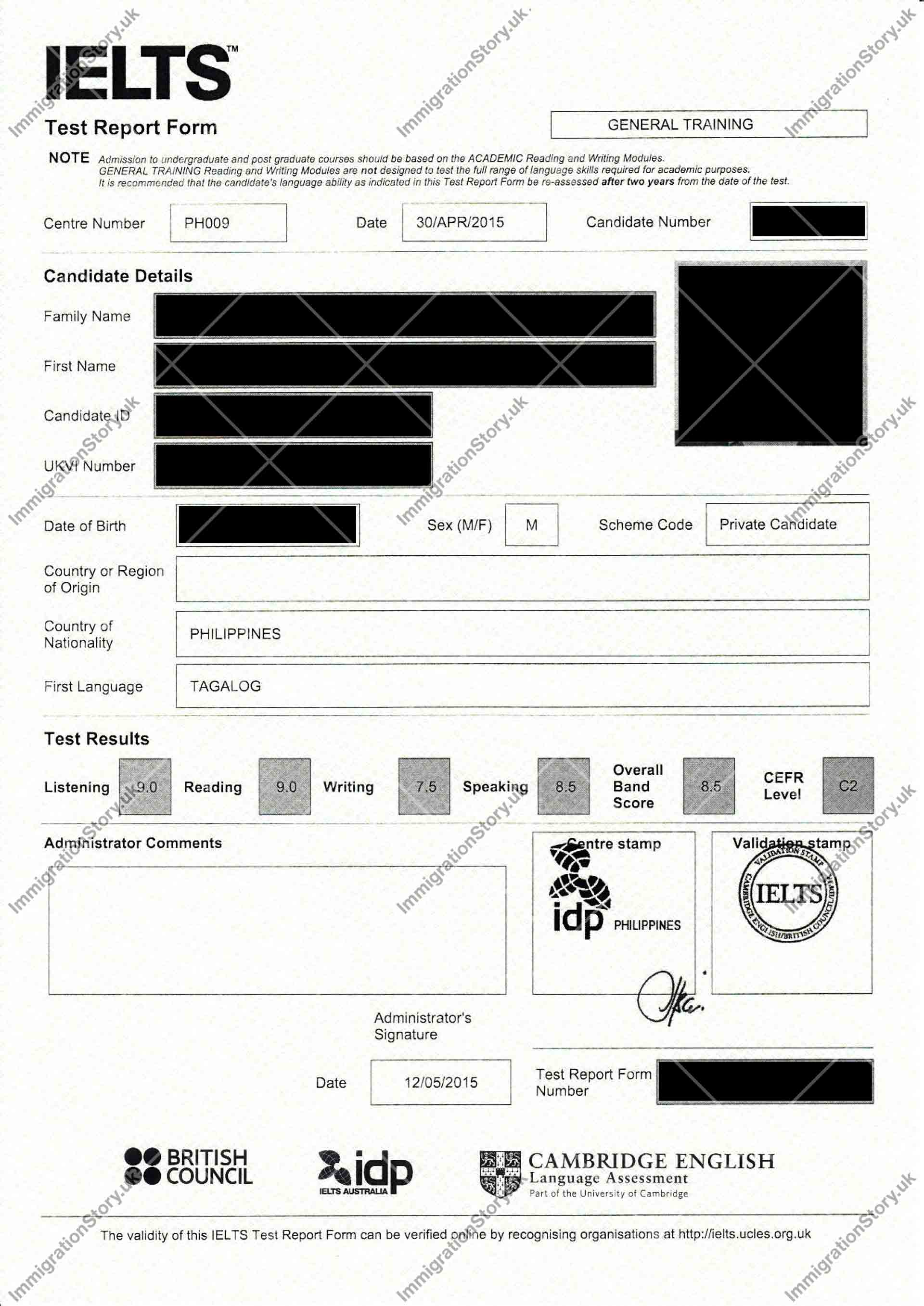The IELTS English Language Test
30 Jul 2020, updated 15 Aug 2020In this chapter I’ll detail:
- Booking the IELTS English Language Test
- Day 1: Speaking Test
- Day 2: Listening, Reading, and Writing Tests
- Results
- A word of warning
Note that the information here is:
- Specific to our unique circumstances
- Reflective of the rules, policies, and requirements, as of the time of our original application for a Tier 2 (General) visa back in 2015; if we are aware of any changes since, it will be called out
If you are planning to apply for, or currently are in the process of applying for a Tier 2 (General) visa then you must refer to the official guidance released by the UK Government at the page for Tier (2) General visas. If you are considering other immigration routes (such as coming to visit as a tourist, or to study, etc) then you can find the official guidance of the UK Government at this visas and immigrations page for all the routes.
Booking the IELTS English Language Test
As part of the visa application process, I had to demonstrate my knowledge of the English language, and one way to do this is to pass an approved English Language Test conducted by a test centre that’s approved by UKVI. This is important as not all test centres are approved, and an approved test centre can conduct both approved and unapproved tests.
To reiterate: both the test centre and the test you are taking need to be approved. You can find the list of approved centres and tests in this official guidance from the UK Government. The names of the unapproved and the approved tests are very similar; you need to pay special attention to what you are booking.
For instance, in my case the most convenient centre was IDP Manila (test centre number PH009). The rightmost column (“Exam”) lists the approved tests that I can take for this centre.
Unfortunately if you follow the standard booking journey, you will ultimately book and pay for a non-UKVI authorised test. To book for the UKVI tests, you had to hunt down a deep link to UKVI-specific bookings and go from there. This was something I immediately noticed upon receiving the booking confirmation email – there seems to be no mention of UKVI anywhere. I contacted the centre by phone, and sure enough, I was informed of the special booking process. I’ve then booked using the correct (more expensive) UKVI process and they’ve cancelled and refunded my original payment.
It seems they have improved the booking journey in 2020 by making the UKVI section more apparent at the start, however it is still problematic as there are no indications you are on the wrong process should you have made the mistake of choosing the incorrect initial option.
The test I ultimately took for the visa application was the IELTS for UKVI (General Training) test.
Another authorised test was the IELTS for UKVI (Academic) test. The key difference between them is that the General Training test (which I took) focuses more on a practical, everyday context, while the Academic test is aimed towards people going into an academic environment. Both tests are valid for use as proof of English language proficiency to meet the requirements of the Tier 2 (General) visa; my decision to take the General Training variant was due to the fact that I am migrating to the UK to work and not to study.
In 2015, booking a UKVI test costed us PHP 14,835.00 (~£226 at the time). The price has actually slightly fallen in 2020 down to PHP 13,885.00 (~£216).
The reason why the UKVI tests are separate (and more expensive) is that the Home Office have issued special guidelines that test centres need to follow in order to eliminate cheating and maintain the integrity of the test. The centre is required to take more measures to secure the UKVI tests as compared to the standard ones.
Day 1: Speaking Test

My IELTS test was scheduled over the course of two days; the first day (29 April 2015) was dedicated to the speaking test.
As this was a secure UKVI test I had to bring the same passport that I used to book the test with, in order for them to verify my identity. Prior to beginning the test, my photo as well as my fingerprints were captured digitally by the test centre.
The test was divided into three parts and are all conducted face-to-face with a certified examiner. Part 1 was focused on introductions and general questions.
In Part 2, the examiner handed me a task card regarding a particular topic, including points that I should incorporate in my talk. I was given one minute to prepare and make notes, which is then followed by me talking about the topic for one to two minutes.
Part 3 was more conversational, where the examiner asked me specific points connected to the topic in Part 2.
All parts of the test were recorded. The entire test took 11 to 14 minutes.
The British Council have made sample speaking tests available which you can use to practice. You will need a study partner to practice with, and listen to you speak.
Day 2: Listening, Reading, and Writing Tests
The second day of my IELTS test was scheduled for 30 April 2015. As with the previous day, this is a secure UKVI test and I had to bring the same passport used to book the test with, which I also brought on Day 1. In addition, I was instructed to bring pencils for use in taking the test.
No personal belongings were allowed in the test room; lockers were provided where these can be stored. Any type of wristwatch (smart or analogue or otherwise) was not permitted.
Listening

There were 40 questions on the listening test divided into four parts, each of which correspond to a recording:
- Recording 1: a conversation between two people set in an everyday social context
- Recording 2: a monologue set in an everyday social context, e.g. a speech about local facilities
- Recording 3: a conversation between up to four people set in an educational or training context, e.g. a university tutor and a student discussing an assignment
- Recording 4: a monologue on an academic subject, e.g. a university lecture
The recordings are played on a speaker in the testing room once. Questions on the sheet need to be answered using your pencil as you listen to the recording.
After all recordings finish (this takes 30 minutes), you are given ten minutes to transfer your answers permanently on the answer sheet using a pen.
The British Council have made sample listening tests available which you can use to practice.
Reading

This focuses on testing how well you understand written passages of text and infer meaning that may be explicit or implied. The content differs depending on whether you are taking the General Training or the Academic test.
The General Training Reading test contained extracts from books, magazines, newspapers, notices, advertisements, company handbooks and guidelines. These are materials you are likely to encounter on a daily basis in an English-speaking environment. This is a 60-minute test, comprised of 40 questions.
The British Council have made sample reading tests available which you can use to practice. You can choose between the General Training or the Academic test variant depending on what you’re taking.
Writing

Finally, the writing test measures how well you can draft a written response, ensuring that your ideas are organised and structured, and that you can accurately use a range of vocabulary and grammar. As with the reading test, the content of the writing test differs between the General Training and the Academic variant.
For the General Training Writing test, the topics were less formal and were of the general interest category. There were two tasks:
- Letter-writing, 20 minutes, 150 words
- Essay-writing, 40 minutes, 250 words
The examiners will not inform you to move from task 1 to task 2 after 20 minutes – you are expected to manage your own time.
The British Council have made sample writing tests available which you can use to practice. You can choose between the General Training or the Academic test variant depending on what you’re taking.
Results
 Results are available 13 days after taking the test.
Results are available 13 days after taking the test.
Under the “Test Results” section of the certificate, a breakdown is provided giving your score (from 0 to 9) for each of the areas (Listening, Reading, Writing, and Speaking), followed by the average, which is your Overall Band Score.

The CEFR level corresponding to your Overall Band Score is then shown. This is what the UKVI will look at – for Tier 2 (General), the CEFR level must be B1 or higher. The list of CEFR levels are as follows:
| Rank | CEFR Level | Description |
|---|---|---|
| Highest | C2 | Mastery / proficiency |
| C1 | Effective operational proficiency / advanced | |
| B2 | Vantage / upper intermediate | |
| B1 | Threshold / intermediate | |
| A2 | Waystage / elementary | |
| Lowest | A1 | Breakthrough / beginner |
A word of warning
Note that in the UK, only OISC-registered immigration advisers can legally give immigration advice. While I hope that I can give you an idea of what the process entails given the recounting here of my experiences, be mindful that this is specific to my case and may not necessarily apply to you or to anyone else.
Immigration law is exceedingly complex. As I am not an immigration adviser and that the strategy we’ve taken in our applications is bespoke to my and my partner’s route and unique state of affairs, the information here is not and should not be constituted as legal advice. If you have any questions regarding your particular circumstances, it is best that you reach out to a qualified immigration adviser who can assess your situation and provide open and honest guidance tailored to your case.
If you decide to do this and seek guidance and/or support from a solicitor (especially if you know that your scenario is a complex one), you must protect yourself from fraud1 by ensuring that you only go to an OISC-registered immigration adviser.